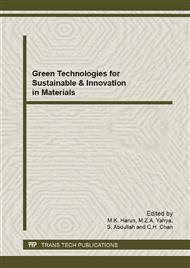[1]
R. Tanaka, W. Rosli, K. Magara, T. Ikeda, S. Hosoya: Chlorine-free bleaching of kraft pulp from oil palm empty fruit bunches, JARQ 38 (2004), p.275–279.
DOI: 10.6090/jarq.38.275
Google Scholar
[2]
H.D. Rozman , K.R. Ahmadhilmi, A. Abubakar: Polyurethane (PU)-oil palm empty fruit bunch (EFB) composites: the effect of EFBG reinforcement in mat form and isocyanate treatment on the mechanical properties, Polymer Testing 23 (2004), p.559–565.
DOI: 10.1016/j.polymertesting.2003.11.004
Google Scholar
[3]
R. Martín-Sampedro, A. Rodríguez, A. Ferrer, L.L. García-Fuentevilla, M.E. Eugenio: Biobleaching of pulp from oil palm empty fruit bunches with laccase and xylanase, Bioresource Technology 110 (2012), p.371–378.
DOI: 10.1016/j.biortech.2012.01.111
Google Scholar
[4]
I.A.W. Tan, B.H. Hameed, A.L. Ahmad: Equilibrium and kinetic studies on basic dye adsorption by oil palm fibre activated carbon, Chemical Engineering Journal 127 (2007), pp.111-119.
DOI: 10.1016/j.cej.2006.09.010
Google Scholar
[5]
B.H. Hameed, I.A.W. Tan, A.L. Ahmad: Optimization of basic dye removal by oil palm fibre-based activated carbon using response surface methodology, Journal of Hazardous Materials 158 (2008), pp.324-332.
DOI: 10.1016/j.jhazmat.2008.01.088
Google Scholar
[6]
G. G. Stavropoulos, P. Samaras, G. P. Sakellaropoulos, Effect of activated carbons modification on porosity, surface structure and phenol adsorption, Journal of Hazardous Materials 151 (2008), 414-421.
DOI: 10.1016/j.jhazmat.2007.06.005
Google Scholar
[7]
R. C. Bansal, M. Goyal: Activated Carbon Adsorption, Taylor % Francis Group (2005).
Google Scholar
[8]
M. J. S. Montero, F. Salvador, C. Izquierdo: Reactivity and porosity of a carbon fiber activated with supercritical CO₂, J. Phys. Chem. C 112 (2008), pp.4991-4999.
DOI: 10.1021/jp709647y
Google Scholar
[9]
K.P. Gadkaree: Carbon honeycomb structures for adsorption applications, Activated Carbon Compendium (2001), pp.47-55.
Google Scholar
[10]
Cigdem Sentorun-Shalaby, Mine G. Ucak-Astarhoglu, Levent Artok, Cigdem Sarici: Preparation and characterization of activated carbons by one-step steam pyrolysis/activation from apricot stones, Microporous and Mesoporous Materials 88 (2006).
DOI: 10.1016/j.micromeso.2005.09.003
Google Scholar
[11]
Kunquan Li, Zheng Zheng, Ye Li: Characterization and lead adsorption properties of activated carbons prepared from cotton stalk by one-step H3PO4 activation, Journal of Hazardous Materials 181 (2010), p.440–447.
DOI: 10.1016/j.jhazmat.2010.05.030
Google Scholar
[12]
Kunbin Yang, Jinhui Peng, Hongying Xia, Libo Zhang, C. Srinivasakannan, Shenghui Guo: Textural characteristics of activated carbon by single step CO₂ activation from coconut shells, Journal of the Taiwan Institute of Chemical Engineers 41 (2010).
DOI: 10.1016/j.jtice.2009.09.004
Google Scholar
[13]
Aik Chong Lua, Jia Guo: Activated carbon prepared from oil palm stone by one-step CO₂ activation for gaseous pollutant removal, Carbon 38 (2000), pp.1089-1097.
DOI: 10.1016/s0008-6223(99)00231-6
Google Scholar
[14]
B.H. Hameed, I.A.W. Tan and A.L. Ahmad: Preparation of oil palm empty fruit bunch-based activated carbon for removal of 2, 4, 6-trichlorophenol: Optimization using response surface methodology. Journal of Hazardous Materials, 164 (2009).
DOI: 10.1016/j.jhazmat.2008.09.042
Google Scholar
[15]
W. Z Shen, Z.J. Li and Y.H. Liu: Surface Chemical Functional Groups Modification of Porous Carbon. Recent Patents on Chemical Engineering 27, 40 (2008), pp.27-40.
DOI: 10.2174/2211334710801010027
Google Scholar
[16]
A. Edwin Vasu: Surface Modification of Activated Carbon for Enhancement of Nickel(II) Adsorption. E-Journal of Chemistry 5 (2008), pp.814-819.
DOI: 10.1155/2008/610503
Google Scholar
[17]
T.H. Liou and S.J. Wu: Characteristics Of Microporous/Mesoporous Carbons Prepared From Rice Husk Under Base- And Acid-Treated Conditions. Journal of Hazardous Materials, 171 (2009), pp.693-703.
DOI: 10.1016/j.jhazmat.2009.06.056
Google Scholar
[18]
A.P. Terzyk: The influence of activated carbon surface chemical composition on the adsorption of acetaminophen (paracetamol) in vitro Part II. TG, FTIR, and XPS Analysis of Carbons and the Temperature Dependence of Adsorption Kinetics at the Neutral pH. Colloids and Surfaces A: Physicochemical and Engineering Aspects, 177 (2001).
DOI: 10.1016/s0927-7757(00)00594-x
Google Scholar
[19]
S. Hadi and K. Tahereh: Investigation Of Nitric Acid Treatment Of Activated Carbon For Enhanced Aqueous Mercury Removal. Journal of Industrial and Engineering Chemistry, 16 (2010), pp.852-858.
DOI: 10.1016/j.jiec.2010.03.012
Google Scholar
[20]
B. K. Pradhan and N. K. Sandle: Effect of different oxidizing agent treatments on the surface properties of activated carbons, Carbon, 37, (1999) p.1323–1332.
DOI: 10.1016/s0008-6223(98)00328-5
Google Scholar


